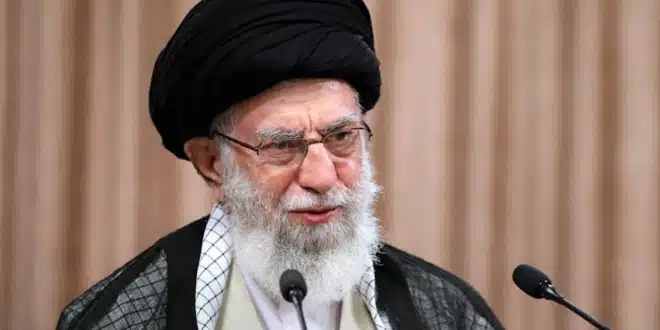The armed conflict between Israel and Iran entered its sixth day on Wednesday, intensifying with cross-border attacks, targeted strikes on nuclear infrastructure, and heated rhetoric from both Tehran and Washington. Iran’s Supreme Leader Ayatollah Ali Khamenei addressed the nation via state television, rejecting U.S. President Donald Trump’s demand for unconditional surrender and warning of severe consequences should the United States choose to intervene.
Khamenei, who has held Iran’s highest political and religious position since 1989, emphasized that Iran would not yield to pressure and characterized the American position as unacceptable. He cautioned that any military action by the United States would lead to irreversible damage. His statement follows a period of rapidly escalating hostilities, triggered last Friday when Israel launched widespread airstrikes targeting Iranian military and nuclear facilities.
Targeted Strikes and Strategic Retaliation
According to Israeli military sources, over 50 fighter jets have carried out attacks in and around Tehran in recent days. Several locations involved in the production of centrifuge components were reportedly destroyed, including two buildings in Karaj, a city near the capital. A facility manufacturing and testing advanced centrifuge rotors was also hit in Tehran itself. The International Atomic Energy Agency (IAEA) later confirmed damage to sensitive areas of Iran’s nuclear infrastructure, stating that underground enrichment halls at the Natanz site may have sustained direct hits.
Centrifuges are critical for uranium enrichment, a dual-use process that can generate nuclear fuel or, at higher concentrations, material suitable for nuclear weapons. Israel has long opposed Iran’s nuclear ambitions, alleging that Tehran aims to acquire atomic arms—an accusation Iran consistently denies.
In response, Iran’s Islamic Revolutionary Guard Corps launched hypersonic Fattah-1 missiles targeting Tel Aviv. These missiles are capable of flying at over five times the speed of sound and can maneuver mid-flight, complicating interception efforts. Although no direct impacts were recorded in Tel Aviv, Israeli air defense systems were activated, with missile interceptions causing explosions visible above the city.
Iran also deployed a swarm of drones toward Israel. The Israeli military reported intercepting 10 of them and confirmed that one of its own drones was downed over Iranian territory. The aerial exchanges have disrupted civilian life across both countries and have raised concerns about broader destabilization across the Middle East.
Civilian Impact and International Fallout
The military campaign has not been confined to strategic sites. Residential neighborhoods in both Israel and Iran have come under fire, leading to civilian casualties and large-scale evacuations. According to Israeli authorities, at least 24 people have been killed in Israel and hundreds injured since the fighting began. Iran’s latest official figures, issued on Sunday, report 224 fatalities, including senior military personnel, scientists involved in the nuclear program, and civilians. No updated casualty numbers have been released by Iranian officials since then.
Cities across Israel have been placed on high alert. In Tel Aviv, air raid sirens have repeatedly sent residents to shelters. Onlookers in nearby Ramallah reported seeing the night sky lit by interceptors and mid-air detonations, while some locals watched the unfolding events from rooftops. In Iran, panic buying has led to long queues outside bakeries and gas stations as residents stockpile essential supplies.
U.S. President Donald Trump, who departed early from the G7 summit in Canada as tensions escalated, has continued to assert that the United States has precise knowledge of Khamenei’s location and the capability to eliminate him. In a post on his Truth Social platform, Trump claimed that although Khamenei is currently safe, he remains a potential target. However, he added that the United States would refrain from such action, at least for now.
The White House convened a National Security Council meeting to review the situation. While no immediate decisions were announced, officials reiterated that military intervention remains an option under discussion. For now, the United States continues to support Israel diplomatically and materially, though it has not engaged directly in the conflict.
Wider Nuclear Implications and Intelligence Developments
The conflict has disrupted backchannel nuclear negotiations between Tehran and Washington. Following the initial Israeli strikes, Iranian authorities declared they would not engage in diplomatic talks with the United States while under attack. The breakdown in dialogue complicates efforts to manage Iran’s nuclear program through diplomatic means.
In the meantime, the UN nuclear watchdog has expressed concern over the damage inflicted on Iran’s nuclear sites. The extent of the destruction at Natanz and other facilities may take time to fully assess, but early observations suggest that centrifuge production and enrichment operations have been significantly impacted.
In a separate development, Iranian media reported the arrest of five individuals accused of working with Israel’s Mossad intelligence agency. The suspects were allegedly involved in online operations intended to undermine Iran’s national image.
According to the Stockholm International Peace Research Institute, Israel is believed to possess approximately 90 nuclear warheads, although the country maintains a policy of strategic ambiguity regarding its nuclear arsenal. The possibility of further escalation now raises broader questions about nuclear stability in the region.


